What's inside
What's inside
 Key Ingredients
Key Ingredients

 Benefits
Benefits

 Concerns
Concerns

 Ingredients Side-by-side
Ingredients Side-by-side

Water
Skin ConditioningSodium Laureth Sulfate
CleansingCocamidopropyl Betaine
CleansingPropylene Glycol
HumectantLaureth-7 Citrate
CleansingParfum
MaskingGlycerin
HumectantSodium Chloride
MaskingCoco-Glucoside
CleansingLonicera Caprifolium Flower Extract
PerfumingLonicera Japonica Flower Extract
Skin ConditioningPolyquaternium-7
Hydrogenated Palm Glycerides Citrate
EmollientEthylhexyl Salicylate
UV AbsorberButyl Methoxydibenzoylmethane
UV AbsorberDiethylhexyl Syringylidenemalonate
Skin ProtectingPPG-2 Hydroxyethyl Cocamide
EmulsifyingHydroxycitronellal
PerfumingLinalool
PerfumingLimonene
PerfumingTetrasodium Glutamate Diacetate
Sodium Phytate
Tocopherol
AntioxidantAlcohol Denat.
AntimicrobialSodium Benzoate
MaskingPhenoxyethanol
PreservativeCitric Acid
BufferingSodium Hydroxide
BufferingPEG-150 Pentaerythrityl Tetrastearate
EmulsifyingCI 17200
Cosmetic ColorantCI 42090
Cosmetic ColorantWater, Sodium Laureth Sulfate, Cocamidopropyl Betaine, Propylene Glycol, Laureth-7 Citrate, Parfum, Glycerin, Sodium Chloride, Coco-Glucoside, Lonicera Caprifolium Flower Extract, Lonicera Japonica Flower Extract, Polyquaternium-7, Hydrogenated Palm Glycerides Citrate, Ethylhexyl Salicylate, Butyl Methoxydibenzoylmethane, Diethylhexyl Syringylidenemalonate, PPG-2 Hydroxyethyl Cocamide, Hydroxycitronellal, Linalool, Limonene, Tetrasodium Glutamate Diacetate, Sodium Phytate, Tocopherol, Alcohol Denat., Sodium Benzoate, Phenoxyethanol, Citric Acid, Sodium Hydroxide, PEG-150 Pentaerythrityl Tetrastearate, CI 17200, CI 42090
 Reviews
Reviews

Ingredients Explained
These ingredients are found in both products.
Ingredients higher up in an ingredient list are typically present in a larger amount.
Alcohol Denat. is an alcohol with a denaturant property. It is created by mixing ethanol with other additives.
This ingredient gets a bad rep because it is irritating and drying - mostly due to its astringent property. Astringents draw out natural oils in tissue, constricting pores and leaving your skin dried out.
However, alcohol denat. is not all that bad.
Due to its low molecular weight, alcohol denat. tends to evaporate quickly. One study on pig skin found half of applied alcohol evaporated in 10 seconds and less than 3% stayed on skin.
This also helps other ingredients become better absorbed upon application.
Studies are conflicted about whether this ingredient causes skin dehydration. One study from 2005 found adding emollients to propanol-based sanitizer decreased skin dryness and irritation. Another study found irritation only occurs if your skin is already damaged.
Small amounts of alcohol are generally tolerated by oily skin or people who live in humid environments.
The rule of thumb is if this alcohol is near the end of an ingredients list, it will probably not affect your skin much.
Also...
This ingredient has antimicrobial and solvent properties.
The antimicrobial property helps preserve products and increase their shelf life. As a solvent, it helps dissolve other ingredients.
Other types of astringent alcohols include:
Learn more about Alcohol Denat.Limonene is a fragrance that adds scent and taste to a formulation.
It's found in the peel oil of citrus fruits and other plants such as lavender and eucalyptus. The scent of limonene is generally described as "sweet citrus".
Limonene acts as an antioxidant, meaning it helps neutralize free radicals.
When exposed to air, oxidized limonene may sensitize the skin. Because of this, limonene is often avoided by people with sensitive skin.
The term 'fragrance' is not regulated in many countries. In many cases, it is up to the brand to define this term. For instance, many brands choose to label themselves as "fragrance-free" because they are not using synthetic fragrances. However, their products may still contain ingredients such as essential oils that are considered a fragrance.
Learn more about LimoneneTocopherol (also known as Vitamin E) is a common antioxidant used to help protect the skin from free-radicals and strengthen the skin barrier. It's also fat soluble - this means our skin is great at absorbing it.
Vitamin E also helps keep your natural skin lipids healthy. Your lipid skin barrier naturally consists of lipids, ceramides, and fatty acids. Vitamin E offers extra protection for your skin’s lipid barrier, keeping your skin healthy and nourished.
Another benefit is a bit of UV protection. Vitamin E helps reduce the damage caused by UVB rays. (It should not replace your sunscreen). Combining it with Vitamin C can decrease sunburned cells and hyperpigmentation after UV exposure.
You might have noticed Vitamin E + C often paired together. This is because it is great at stabilizing Vitamin C. Using the two together helps increase the effectiveness of both ingredients.
There are often claims that Vitamin E can reduce/prevent scarring, but these claims haven't been confirmed by scientific research.
Learn more about TocopherolWater. It's the most common cosmetic ingredient of all. You'll usually see it at the top of ingredient lists, meaning that it makes up the largest part of the product.
So why is it so popular? Water most often acts as a solvent - this means that it helps dissolve other ingredients into the formulation.
You'll also recognize water as that liquid we all need to stay alive. If you see this, drink a glass of water. Stay hydrated!
Learn more about Water